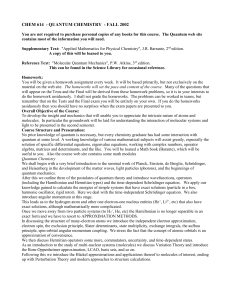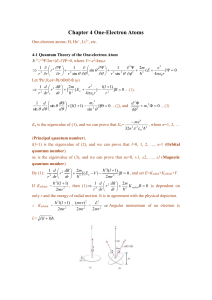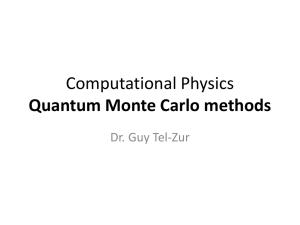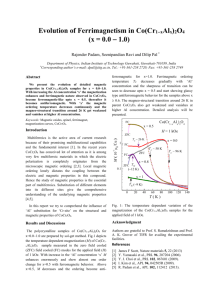Ch_8
advertisement
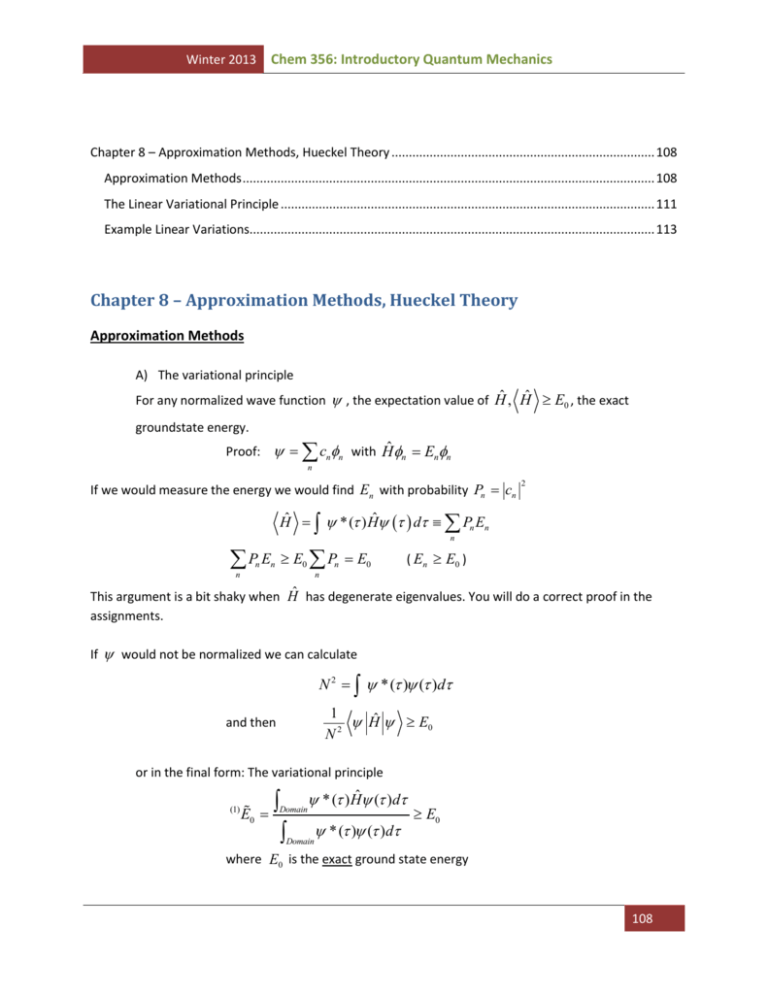
Chem 356: Introductory Quantum Mechanics Winter 2013 Chapter 8 – Approximation Methods, Hueckel Theory ............................................................................ 108 Approximation Methods ....................................................................................................................... 108 The Linear Variational Principle ............................................................................................................ 111 Example Linear Variations..................................................................................................................... 113 Chapter 8 – Approximation Methods, Hueckel Theory Approximation Methods A) The variational principle For any normalized wave function , the expectation value of Hˆ , Hˆ E0 , the exact groundstate energy. Proof: c n n with Hˆ n Enn n If we would measure the energy we would find En with probability Pn cn 2 Hˆ *( ) Hˆ d Pn En n P E n E0 Pn E0 n n ( En E0 ) n This argument is a bit shaky when Ĥ has degenerate eigenvalues. You will do a correct proof in the assignments. If would not be normalized we can calculate N 2 * ( ) ( )d 1 Ĥ E0 N2 and then or in the final form: The variational principle (1) E0 * ( ) Hˆ ( )d Domain * ( ) ( )d E0 Domain where E0 is the exact ground state energy 108 Chem 356: Introductory Quantum Mechanics Winter 2013 The variational energy E0 , is exact when ( ) 0 ( ) , the exact ground state wavefunction. Examples: use a trial wavefunction that depends on one or more parameters , … Then minimize the trial energy E , Some simple (trivial) examples: 1 d2 1 2 Hˆ h.u x 2 2 dx 2 Take trial wavefunction of the type ( x) e x /2 2 Ne x Or 2 /2 ? What is E0 ? Q: what is A: The exact wavefunction has the form Ne x Q: 1 2 1 by minimizing the energy we should get 1 , E0 2 Take the Hamiltonian for the Hydrogen atom, and an l 0 state Hˆ 2 /2 , E0 d 2 d e2 r 2 r 2 dr dr 4 0 r 2 Take the trial wavefunction e r - What are the integrals to evaluate? What is the optimal value for ? - What is the value for E0 ? A: E0 ( ) ˆ r dr 4 r 2 e r He 0 4 r 2 e r e r dr 0 Minimizing : opt 1 a0 E0 ( ) 0 E0 E0 1 e2 2 4 0 a0 again: exact a0 4 0 me2 2 You can do those problems yourself and see if you get the correct answer Nontrivial example: Take the Hamiltonian for H-atom, s-orbital, and use the trial wavefunction e r 2 Chapter 8 – Approximation Methods, Hueckel Theory 109 Winter 2013 Chem 356: Introductory Quantum Mechanics E0 ( ) 2 ˆ r 2 dr 4 r 2 e r He 0 4 r 2 e r e r dr 2 2 ... 0 1 3 2 2e2 2 2me 0 (2 )3/2 E0 3 2 e2 0 2me (2 )3/2 0 1/2 1 2 opt 2me e 2 3(2 )3/2 0 me 2 e4 18 3 0 2 4 E0 ( opt ) 3 E0 4 me e4 2 16 0 E0 ( opt ) 0.424 2 2 e2 4 0 a0 1 e2 2 4 0 a0 E0 E0 now, since the trial wavefunction cannot be exact for any Note: Gaussian trial orbitals (basis sets) are widely used in electronic structure programs. This is because integrals are easily evaluated over Gaussians. This is the origin of the name for the Gaussian Program: It uses Gaussian basic functions! Chapter 8 – Approximation Methods, Hueckel Theory 110 Winter 2013 Chem 356: Introductory Quantum Mechanics The Linear Variational Principle Consider a trial wave function ( ) cn f n ( ) n Let us assume for simplicity - Real coefficients, functions, f n - Orthonormal expansion functions: Domain f n *( ) f m ( )d nm Then we can try to optimize the coefficients E (c ) 0 * ( ) H ( )d * ( ) ( )d N D N cn f n ( ) Hcm f m ( )d ˆ ( )d cn cm f n ( ) Hf m n,m cn H nm cm n,m D cn f n ( )cm f m ( )d n,m cn cm f n ( ) f m ( )d n,m cn cm n ,m cn 2 n ,m Then n E 0 k ck N D DN ck N ck 0 2 ck D D Or N N D ck D ck N D E ck ck N H km cm cn H nk ck m n D ck ck c n 2 2ck n Chapter 8 – Approximation Methods, Hueckel Theory 111 Winter 2013 Chem 356: Introductory Quantum Mechanics H km cm Eck cn H nk Eck 0 m n Since H nk H kn , this is twice the same equation. H c Eck 0 km m This has the form of a matrix eigenvalue equation! m H k H km H and c c E H c ck E km m m We can also write H E km c 0 This has the form of a linear equation. Ac 0 , with A H E1 This type of equation only has a solution which det A 0 . Hence det H E1 0 equation for E “secular determinant” Let us discuss examples later. For now I want to draw the analogy: Schrodinger equation Ĥ E If we make a basis expansion cn f n f n | f m nm n Then we get a matrix type Schrodinger equation Hc Ec With H H nm n *( ) Hˆ m ( )d Such an eigenvalue equation has M solutions for an M M matrix. They represent approximations to the ground and excited states. If the basis is not orthonormal the define Snm Or n * ( ) Hm ( )d and Hc ScE (see MQ) det H SE 0 eigenvalues E . Chapter 8 – Approximation Methods, Hueckel Theory 112 Winter 2013 Chem 356: Introductory Quantum Mechanics Example Linear Variations Consider particle in the box 2 d2 H 2m dx 2 2 n x sin n a n ( x) Now add to H a linear potential Use as a trial wave function c1 i, j 1, 2 V0 x a 2 x 2 2 x sin c2 sin a a a a 2 2 i x d 2 V0 H ij sin a a 2m dx 2 a V0 16V0 E1 2 9 2 V0 16V0 2 E2 2 9 n2 2 2 En 2ma 2 0 0 1 2 H 2 16 2mn 0 9 2 2 2 2 The eigenvalues of this Hamiltonian are 2 2ma 2 2ma 2 2 16 20 9 0 4 2 2 j x x sin a V0 n V0 5 0 3 2 V 2 2 4 0 2 This happens to be pretty good solution, especially as V0 is small 1/2 2 5 0 1 320 n 9 2 2 9 2 1 Chapter 8 – Approximation Methods, Hueckel Theory 113 Winter 2013 Chem 356: Introductory Quantum Mechanics Other instructive example: consider particle on the ring 2 , with the degenerate m 1 solutions 2mR 2 2 1 cos 2 E1 1 2mR 2 sin e Now apply a magnetic field, which adds Be Lˆz Lˆz to the Hamiltonian Lˆz i 2me 2 Under the influence of the perturbation the levels split. Calculate the energy splitting. I used wrong formula; sign is wrong e 2me c1 H H 0 Lz 1 cos c2 1 sin 1 1 z Lˆz cos i sin 1 1 Lˆz sin i cos 2 E i 2 2mR H E 1 = 2 E i 2 2mR 2 2 2 det H EZ E 2 2mR 2 0 2 E 2 2mR E 2 2mR 2 Chapter 8 – Approximation Methods, Hueckel Theory 114 Winter 2013 Chem 356: Introductory Quantum Mechanics Can I find eigenfunctions? 2 2 2mR i 1 2 1 2 2 i 2mR i 2 2mR 2 2 2mR i 1 2 1 2 2 i 2mR i 2 2mR i i What are the eigenfunctions then? 1 i cos i sin ~ e i 1 i cos i sin ~ e i (we normalize, 1 factor) 2 2 2 2 i i e ei 2 2 2 2mR 2mR 2 2 2 i i e ei 2 2 2 2mR 2mR Bottom line: We can indicate perturbation H H 0 V Diagonalize H over degenerate states. Examples: ( ne ) H-atom: H H 0 g (v) L S Diagonalize Ĥ over 2p orbitals … 2 p 3 , 2 p 1 eigenfunctions from diagonalizing 6 6 2 2 Hamiltonian. Everything comes out by brute force. Example 2: add in additional magnetic interaction H H 0 ( ne ) g (v) L S e 2e Bz Lz Bz Sˆz 2me 2me diagonalize H over 2p and 2s orbitals all the splitting from diagonalization The linear variational principle is a very powerful tool to calculate approximate eigenfunctions Chapter 8 – Approximation Methods, Hueckel Theory 115 Winter 2013 Chem 356: Introductory Quantum Mechanics It is widely used to calculate the splitting of energies in a degenerate manifold, when adding a perturbation. When the energies of a Hamiltonian H 0 are not degenerate, one can get a good estimate of the energy correction due to a perturbation V , by calculating V . Hence if H 0n En (0)n , then eigenvalues of Hˆ Hˆ e Vˆ are given to first approximation by n Hˆ n n * ( ) H 0 V n ( )d En (0) n * ( )V n ( )d These are just the diagonal elements of the Hamiltonian matrix = First order Perturbation Theory: If we go back to box + linear field H 2 V d2 0x 2 2m dx a Ĥ 0 v̂ 2 2 2 n x sin En (0) a a 2ma 2 V 2 a n x n Vˆ n 0 sin xdx a a 0 a n V0 2 a V0 a a 2 a V V 0 all energies are shifted by 0 a a En En (0) If zero-order states are degenerate, first-order perturbation theory is useless. Instead use linear variational principle Example Lˆ z in sin(mx) basis choose other basis: results e im e im always diagonalize over zeroth-order states: degenerate first-order perturbation theory Another example of Hc cE : Hückel -electron theory In organic chemistry, many molecules are essentially planar. The plane contains “ sp 2 ” carbon, oxygen, nitrogen atoms. The out of plane Pz -orbitals constitute the -orbitals. The molecule’s - orbitals are Chapter 8 – Approximation Methods, Hueckel Theory 116 Winter 2013 Chem 356: Introductory Quantum Mechanics linear combinations of the atomic Pz -orbitals. One can parameterize a one-electron effective Hamiltonian matrix as follows. Let us restrict ourselves to sp 2 carbons. H 0 0 0 H 0 0 0 0 0 H 0 0 0 0 0 0 H 0 0 D Rule: on diagonal for any two adjacent atoms connected by a -bond 0 ~ Pz (1)V Ne Pz (2) d Following the variational principle we a) Diagonalize the Hamiltonian orbital energies Ek , eigenvectors ck b) Fill up orbital levels from the bottom up putting an and a electron in each level. Occupy as many levels as you have -electrons c) If levels are degenerate, fill them up with -electrons first, then add additional electrons d) Total energy: E occupied orbitals e) Density Matrix Dkl , occupied ck cl E H kl Dkl (see McQuarrie) kl Chapter 8 – Approximation Methods, Hueckel Theory 117 Winter 2013 Chem 356: Introductory Quantum Mechanics This procedure would work fine in MathCad How do we do it on paper? Take det H E1 E 0 E ethylene E 2 0 2 E E 2 - electrons Using and is a bit tedious for larger problems divide each column by and define x E E x x 1 x2 1 0 1 x E x 1 Or x 1 1 1 x 1 0 1 1 x x 1 1 1 x 1 x3 1 1 x x x x3 3x 2 0 x 1 1 3 2 0 x 2 8 6 2 0 x Always: i 0 TrN i x 1 is double solution. x 1 x 2 x2 2x 1 x 2 2 x3 3x 2 ok Chapter 8 – Approximation Methods, Hueckel Theory 118 Winter 2013 Chem 356: Introductory Quantum Mechanics Ek xk 3 -electrons (4-fold degenerate) Triplet (3-fold degenerate) Singlet What if we would look at the singlet state of the anion? This is not a stable structure, the molecule would distort Jahn-Teller Distortion! I might ask questions of 4 * 4 determinant too hard to solve Chapter 8 – Approximation Methods, Hueckel Theory 119 Winter 2013 Chem 356: Introductory Quantum Mechanics I would give you the solution x1 , x2 , x3 , x4 You show that ( x x1 )( x x2 )( x x3 )( x x4 ) is your secular determinant You can guess the orbitals (phases) from symmetry arguments: The orbitals are always symmetric or antisymmetric with respect to plane or axis of symmetry If you know value of x you can solve x 1 : x 1 1 a 1 x 1 b 0 1 1 x c abc 0 (1 -1 0) 1 1 -2 orthogonal combinations x 2 : 2 1 1 1 0 1 2 1 1 0 1 1 2 1 0 Chapter 8 – Approximation Methods, Hueckel Theory 120
